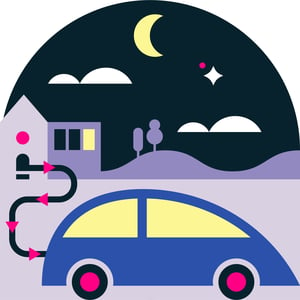The future of energy: from smart homes to virtual power plants
You find the best electricity tariff that you can and then leave the rest to your energy supplier, until a bill lands on your doorstep. That’s the reality for most households.
But evolving technology, the digitalisation of the energy system – starting, at its most basic, with smart meters - and the development of new ways to generate, store and exchange energy is dramatically changing the energy system.
For many UK households, the smart energy revolution has begun, and it will help consumers save money and cut carbon emissions.
Take control
The first step in the smart energy revolution is to understand and gain more control over your home energy use, enabling you to become much more energy efficient. That can be achieved through a smart meter and then a more sophisticated device like Loop, which enables you to monitor your energy use in real-time and make decisions based on the information.
The next step, which many households have also already taken, is to generate your own renewable power. The most popular way of doing this is to install solar panels on your roof to convert sunlight into cheap and green energy.
Solar panels generate renewable energy during the day and this energy is used to supply electricity to your home. You reduce your dependence on the National Grid and on dirty fossil fuels, which contribute to climate change.

Store your energy
But solar panels don’t store the energy to use when the sun isn’t shining. So surplus energy that you don’t use is ‘exported’ to the local electricity grid (which you could get paid for under the new Smart Export Guarantee). And when the panels aren’t generating enough energy for your needs, you need to buy electricity from your supplier.
To really make the most of your solar panels, you would have a battery in your home to store the energy and use it later in the day. This would help you cut the amount of electricity you need to buy from the grid, saving you money on your bill.
Most batteries enable you to track your energy use online and decide when to charge your storage unit and when you need to draw on that power.
They can also be charged overnight when grid electricity is cheap, for example if you have a time of use tariff.
Pair it with an electric car
To really make the most of your solar generation and battery, combine them with an electric vehicle.
If you’re on an off-peak overnight electricity tariff, charging your car at night at a lower rate makes a lot of sense. That could work both ways too; ‘Vehicle to Grid’ systems are being trialed which automatically charge your car when demand on the grid is low, and then sell the energy back to the grid when demand is high. So, you save money, and also help to reduce pressure on the grid.
Now you’re entering the realm of virtual power plants. This is when solar panels, batteries and electric vehicles are all linked together to cut energy bills, reduce carbon emissions, and help manage the electricity system more efficiently.
Such smart energy systems can be large scale. In West Sussex, a virtual power plant is being created to link solar panels, batteries and electric vehicles in hundreds of homes, schools and council buildings. It’s hoped the scheme will cut energy costs by 10%, save nearly 2000 tonnes of CO2 emissions a year, and would save the UK £32 billion if rolled out nationally.

Trade with your neighbours
Peer-to-peer trading has changed the way people lend, invest, get around (think Uber) and rent holiday lets (Airbnb). So why not energy?
Rather than selling and buying from the grid, it’s expected that people will be able to trade electricity directly with their neighbours and wider community.
In fact, this has already begun. At a housing estate in Brixton in London residents are taking part in a trial to trade energy generated by solar panels using blockchain technology.
P2P schemes could support local communities, suggest researchers at University College London. For example, they say: “Parents may choose to buy electricity from the roof of their children’s school to help support the school and provide learning opportunities in science classes for pupils. Alternatively, people could choose to sell energy at a discount to family members or donate some to local charities supporting those in fuel poverty.”
Such trials are just the start. A huge amount of energy and effort is going into creating an energy system that works better for everyone, saves money and helps reduce dependence on the grid and fossil fuels.
• • •
With Loop, you can find out how you use electricity, then make smart decisions about using less - click here to find out more. We have a risk-free, no-quibble, money-back guarantee as standard, so what's to lose...apart from some £££ from your bills and some weight from your carbon footprint?







